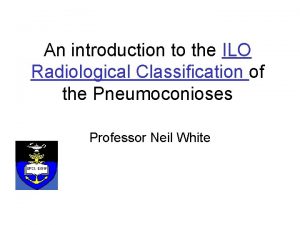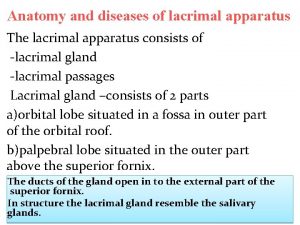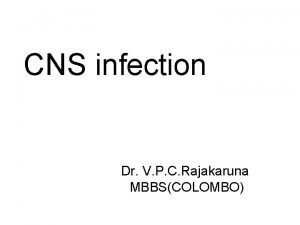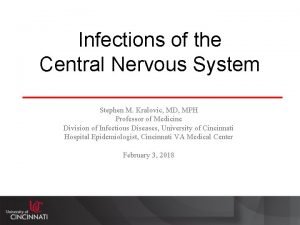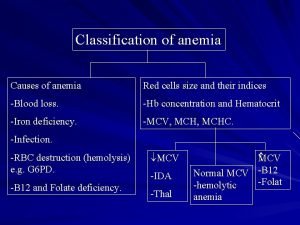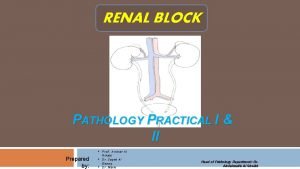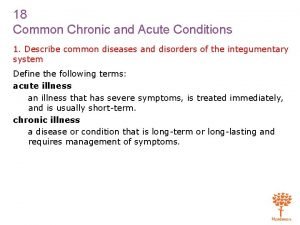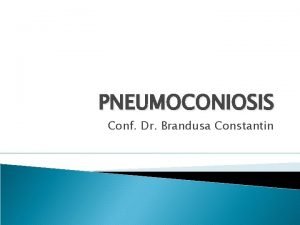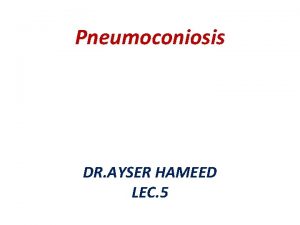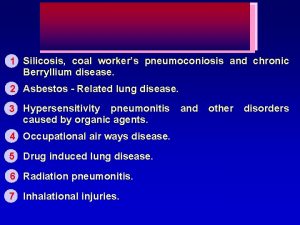Pneumoconiosis Pneumoconiosis Pneumoconioses encompass a group of chronic

































- Slides: 33

Pneumoconiosis

Pneumoconiosis • Pneumoconioses encompass a group of chronic fibrosing diseases of the lung resulting from exposure to organic and inorganic particulates, most commonly mineral dust


• Pathogenesis(1) amount of dust (2) size, shape, and buoyancy of the particles o small particles, 1 to 5 μm –acute lung injury o Large particle-evoke fibrosing collagenous pneumoconioses (3) particle solubility and physiochemical reactivity-small particles composed of injurious substances of high solubility (4) additional effects of other irritants

• particles stimulate resident innate immune cells in the lung • invokes systemic response • a genetic predisposition

Particles size Ø 2. 5– 10 μm • bronchi and bronchioles • removed by mucociliary action Ø <2. 5 μm- acini Ø<100 nm-penetrate alveolar walls


Silicosis • Silicosis is the most common pneumoconiosis in the world, and crystalline silica (e. g. , quartz) is the usual culprit • caused by inhalation of proinflammatory crystalline silicon dioxide

PathogenesisØcrystalline and amorphous forms • crystalline forms (including quartz, cristobalite, and tridymite)- much more fibrogenic • Phagocytosed silica crystals activate the inflammasome, leading to the release of inflammatory mediators, particularly IL-1 and IL-18

• disease may continue to worsen even if the patient is no longer exposed • It is associated with an increased susceptibility to tuberculosis • Patients with silicosis have double the risk for developing lung cancer

ØSIMPLE NODULAR SILICOSIS: most common form of silicosis ØPROGRESSIVE MASSIVE FIBROSIS: nodular masses greater than 2 cm in diameter, in a background of simple silicosis • bilateral • 5– 10 cm • Central cavitation

ØACUTE SILICOSIS: • heavy exposure to finely particulate silica during sandblasting or boiler scaling • it is associated with diffuse fibrosis of the lung • Silicotic nodules are not found • Microscopically, Dense eosinophilic material accumulates in alveolar spaces

Gross

Progressive massive fibrosis

Several coalescent collagenous silicotic nodules

Coal Workers’ Pneumoconiosis • caused by inhalation of coal particles and other admixed forms of dust • Contaminating silica in the coal dust favour progressive disease • develop emphysema and chronic bronchitis independent of smoking

MORPHOLOGY • Anthracosis is the most innocuous coal-induced pulmonary lesion in coal miners Øcoal macules (1 to 2 mm in diameter) and somewhat larger coal nodules • Coal macules consist of carbon-laden macrophages • Complication- centrilobular emphysema ØComplicated coal workers’ pneumoconiosis (progressive massive fibrosis) • intensely blackened multiple scars 1 cm or larger • Microscopy- dense collagen, pigment , +/- necrosis

• Caplan syndrome- combination of rheumatoid arthritis (RA) and pneumoconiosis that manifests as intrapulmonary nodules, which appear homogenous and welldefined on chest X-ray. • Nodular lesions are large (1– 10 cm), multiple, bilateral • Caplan nodule- combination of silicotic and rheumatoid nodule


Asbestos-Related Diseases • Asbestos (Greek, “unquenchable”) includes a group of fibrous silicate minerals that occur as thin fibers § Chrysotile accounts for the bulk of commercially used asbestos § The amphiboles include amosite, crocidolite, tremolite, actinolite and anthophyllite.

• ASBESTOSIS: Asbestosis is diffuse interstitial fibrosis resulting from inhalation of asbestos fibers • historically seen in asbestos miners, millers and insulators

ETIOLOGIC FACTORS: • Asbestos fibers may be long (up to 100 μm) but thin (0. 5– 1 μm), so their aerodynamic particle diameter is small • They deposit in distal airways and alveoli, particularly at bifurcations of alveolar ducts • first lesion is an alveolitis

PATHOLOGY: • bilateral, diffuse interstitial fibrosis • asbestos bodies in the lung In early stages, fibrosis • end-stage or “honeycomb” lung

Asbestosis

Asbestos bodies

Pleural plaque

• BENIGN PLEURAL EFFUSION • PLEURAL PLAQUESØmost common manifestation of asbestos Øwell-circumscribed plaques of dense collagen often calcified • DIFFUSE PLEURAL FIBROSIS • ROUNDED ATELECTASIS • MESOTHELIOMA • CARCINOMA OF THE LUNG

Berylliosis • pulmonary disease that follows the inhalation of beryllium • materials in aerospace, industrial ceramics and nuclear industries

Pathology • Acute chemical pneumonitis or a chronic pneumoconiosis • 10% progress to chronic disease, Chronic berylliosis • Exposure may be minimal and brief • Microscopically, Multiple noncaseating granulomas are distributed along the pleura, septa and bronchovascular bundles

• may progress to end-stage fibrosis and honeycomb lung • associated with an increased risk of lung cancer

Berylliosis

Talcosis • Prolonged and Heavy Exposure to Talc Dust • magnesium silicates • lubricants, and in cosmetics and pharmaceuticals • Associated minerals such as silica may contribute to the fibrotic changes • Tiny nodules to severe fibrosis • Foreign body granulomas associated with birefringent plate-like talc particles

Thank you
 Chest abnormalities
Chest abnormalities Ilo classification of pneumoconiosis
Ilo classification of pneumoconiosis Encompass
Encompass Five design principles
Five design principles Encompasslit
Encompasslit Accountchek login
Accountchek login Vixie engage consult download
Vixie engage consult download Eight adjacent squares encompass
Eight adjacent squares encompass Factors delaying wound healing
Factors delaying wound healing Lacrimal sac
Lacrimal sac Spondylo definition
Spondylo definition Meningoceal
Meningoceal Peripheral stigmata of cld
Peripheral stigmata of cld Chronic myeloid leukemia
Chronic myeloid leukemia Chronic meningitis
Chronic meningitis Earthy look in chronic renal failure
Earthy look in chronic renal failure Chronic rejection
Chronic rejection Grades of anemia
Grades of anemia Chronic misbehavior
Chronic misbehavior Chronic pancreatitis nursing care plan
Chronic pancreatitis nursing care plan Chronic unease in the workplace
Chronic unease in the workplace Acute and chronic
Acute and chronic Post streptococcal glomerulonephritis
Post streptococcal glomerulonephritis Chronic rejection
Chronic rejection Cholecystitis
Cholecystitis Dr ali azzam
Dr ali azzam 18 common chronic and acute conditions
18 common chronic and acute conditions Chronic inflammation
Chronic inflammation Types of gastritis
Types of gastritis Wagner chronic care model 1998
Wagner chronic care model 1998 Pancreatitis nursing
Pancreatitis nursing Icd 10 seasonal allergies
Icd 10 seasonal allergies Hepatitis c symptoms in men
Hepatitis c symptoms in men Chronic kidney disease near atwater
Chronic kidney disease near atwater

